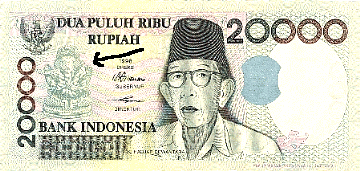Ganesh Chaturthi is one of the biggest festivals held every year in Maharashtra. The Ganesh itself that makes this festival a mammoth one. A journey to ancient Hindu-influenced parts of this world which almost all of them reside in Southeast Asia reveals the fact.
Just like in Cambodia, Vietnam, and some other Southeast Asian countries, Hinduism was a big part of the beliefs of Indonesians. Decrepit and remnants of more than 300 years (some are more than 1000 years) aged temples found and excavated in Indonesia. There located prominent Ganesh statues. Most of them are still intact and preserved in museum and some are still on their places where they were placed more than one hundred decades ago. There are at least more than 15 spots all over Indonesia where Ganesh statues were found. Below are the sites.
|
1. Bara Temple, Tuliskaiyo village, Blitar Regency, East Java. Built in 1239. An immense statue of three meters height Ganesha.

|
2. Ratu Boko, few kilometers from Prambanan Temple. There is an unfinished statue of Ganesha. Built in 9th Century
 |
|
3. Lorojongrang or Prambanan Temple. This magnificent Shivaite temple derives it name from the village where it is located. Locally known as the Loro Jongrang Temple, or the Temple of the "Slender Virgin", it is the biggest and most beautiful Hindu temple in Indonesia. Built in 9th Century.
 |
4. Penataran Temple.
The dated temple. Is engraved on the lintel of the door western side. In the cellar there is a statue of Ganesha. Earliest inscription reveals year 1197 (12th Century).
|
 | |
|
5. Balaputradewa Museum, Palembang, West Sumatera. One of its collections is statue of Ganesha dated back from Sriwijaya Kingdom (7th - 13th Century)

|
6. Sambisari Temple - Jogyakarta.
A statue of Ganesha is on the East side of the temple. Built in 9th Century.
 |
|
Pura Luhur Uluwatu, Bali.
Statues of Ganesha herald at the gate. Built in 15th Century.
 |
|
8. Complex of tombs of the last Hindu Madura and early Islamic Kings. 16th Century. Statue and relief of Ganesha are inside the complex.

|
9. Torongrejo village, Wukir Mt., Malang - East Java.
Archeological excavation revealed Ganesha statue dated back from Singosari Kingdom (13th Century)
10. Ujung Kulon National Park, West Java
Ujung Kulon National Park is the first national park, founded in Indonesia. The park (80,000 ha) lies on a peninsula in southwest Java and includes the islands Pulau Peucang, Pulau Panaitan and the Krakatau archipelago. On 1 February 1992, the Proposed Ujung Kulon National Park complex and the Krakatau Islands Nature Reserve were declared a World Heritage Site. An early Hindu archaeological relic of a Ganesha statue from the first century AD founded in pulau Panaitan on the summit of Mt. Raksa.
|
 |
11. Pura Blanjong, Sanur - Bali.
A Brahmin dominated complex. There inside located Ganesh statue and Bali's oldest inscription dated 914 AD.
12. Gebang Temple, Jogyakarta. A blend of Buddha-Hindu temple. A Ganesh enchased on its architecture.
 |
|
13. Gedongsongo Temple, Candi Village, Ungaran Mt., Semarang - Central Java. Nine small temples with Ganesh relief. 8th Century.

|
14. Sangiran Museum, Sragen, Central Java.
It is a home to magnificent collection of thousand of years of fossils and early historical Indonesia. One of its collections is Ganesh statue.
 |
|
Goa Gajah, Gianyar, Bali. 11th Century.

|
16. Museum Nasional, Jakarta.
One of its huge collections is Ganesh statue found in Banon Temple, Magelang, Central Java. 8th Century
|
 |
 |
In educational institution like Institut Teknologi Bandung (ITB) or Bandung Institute of Technology), the symbol or logo of Ganesh is like an ITB trademark. The picture and ornaments like the broken ivory means Ganesh is willing to sacrifice while the rest represent wisdom and firmness. The using of the logo is widely applied in any of ITB activities that makes the logo is identical to ITB's students. The institute's address itself is Ganesha Road No. 10, Bandung, West java. |
| One of the Indonesian currency notes carries the picture of Ganesh. The currency symbol ("Rp" India = "Rs") and its pronunciation ("Rupiah" - "Rupe") are actually almost similar to India's. |
 |
In India, Ganesh has many names like Ganapati, Vighnesvara, Gajanana, Gajadhipati, Lambkarn, Lambodar and Ekadant, while in Indonesian language is named "Gajah" which is most probably derived from Sanskrit word "Gaja" or elephant.